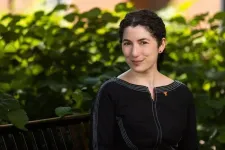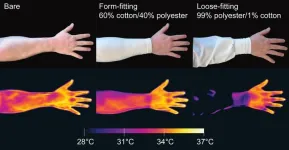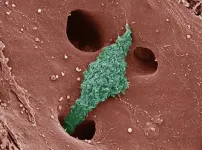(Press-News.org) As climate change creates hotter, drier conditions, we are seeing longer fire seasons with larger, more frequent wildfires. In recent years, catastrophic wildfires have destroyed homes and infrastructure, caused devastating losses in lives and livelihoods of people living in affected areas, and damaged wildland resources and the economy. We need new solutions to fight wildfires and protect areas from damage.
Researchers at Stanford have developed a water-enhancing gel that could be sprayed on homes and critical infrastructure to help keep them from burning during wildfires. The research, published Aug. 21 in Advanced Materials, shows that the new gels last longer and are significantly more effective than existing commercial gels.
“Under typical wildfire conditions, current water-enhancing gels dry out in 45 minutes,” said Eric Appel, associate professor of materials science and engineering in the School of Engineering, who is senior author of the paper. “We’ve developed a gel that would have a broader application window – you can spray it further in advance of the fire and still get the benefit of the protection – and it will work better when the fire comes.
Long-lasting protection
Water-enhancing gels are made of super-absorbent polymers – similar to the absorbent powder found in disposable diapers. Mixed with water and sprayed on a building, they swell into a gelatinous substance that clings to the outside of the structure, creating a thick, wet shield. But the conditions in the vicinity of a wildfire are extremely dry – temperatures can be near 100 degrees, with high winds and zero percent humidity – and even water locked in a gel evaporates fairly quickly.
In the gel designed by Appel and his colleagues, the water is just the first layer of protection. In addition to a cellulose-based polymer, the gel contains silica particles, which get left behind when the gels are subjected to heat. “We have discovered a unique phenomenon where a soft, squishy hydrogel seamlessly transitions into a robust aerogel shield under heat, offering enhanced and long-lasting wildfire protection. This environmentally conscious breakthrough surpasses current commercial solutions, offering a superior and scalable defense against wildfires,” said the lead author of the study, Changxin “Lyla” Dong.
“When the water boils off and all of the cellulose burns off, we’re left with the silica particles assembled into a foam,” Appel said. “That foam is highly insulative and ends up scattering all of the heat, completely protecting the substrate underneath it.”
The silica forms an aerogel – a solid, porous structure that is a particularly good insulator. Similar silica aerogels are used in space applications because they are extremely lightweight and can prevent most methods of heat transfer.
The researchers tested several formulations of their new gel by applying them to pieces of plywood and exposing them to direct flame from a gas hand-torch, which burns at a considerably higher temperature than a wildfire. Their most effective formulation lasted for more than 7 minutes before the board began to char. When they tested a commercially available water-enhancing gel in the same way, it protected the plywood for less than 90 seconds.
“Traditional gels don’t work once they dry out,” Appel said. “Our materials form this silica aerogel when exposed to fire that continues to protect the treated substrates after all the water has evaporated. These materials can be easily washed away once the fire is gone.”
A serendipitous discovery
The new gels build off of Appel’s previous wildfire prevention work. In 2019, Appel and his colleagues used these same gels as a vehicle to hold wildland fire retardants on vegetation for months at a time. The formulation was intended to help prevent ignition in wildfire-prone areas.
“We’ve been working with this platform for years now,” Appel said. “This new development was somewhat serendipitous – we were wondering how these gels would behave on their own, so we just smushed some on a piece of wood and exposed it to flames from a torch we had laying around the lab. What we observed was this super cool outcome where the gels puffed up into an aerogel foam.”
After that initial success, it took several years of additional engineering to optimize the formulation. It is now stable in storage, easily sprayable with standard equipment, and adheres well to all kinds of surfaces. The gels are made of nontoxic components that have already been approved for use by the U.S. Forest Service, and the researchers conducted studies to show that they are easily broken down by soil microbes.
“They’re safe for both people and the environment,” Appel said. “There may need to be additional optimization, but my hope is that we can do pilot-scale application and evaluation of these gels so we can use them to help protect critical infrastructure when a fire comes through.”
For more information
Appel is a senior fellow of the Stanford Woods Institute for the Environment; a member of Stanford Bio-X, the Stanford Cardiovascular Institute, the Wu Tsai Human Performance Alliance, the Maternal & Child Health Research Institute, the Stanford Cancer Institute, and the Wu Tsai Neurosciences Institute; and a faculty fellow of Stanford Sarafan ChEM-H.
Additional Stanford co-authors of this research include postdoctoral researchers Andrea I. d’Aquino and Samya Sen; graduate students Changxin Dong and Anthony C. Yu; and undergraduate student Ian A. Hall.
Other co-authors on this work are from California Polytechnic State University.
This work was funded by the Gordon & Betty Moore Foundation, Schmidt Science Fellows, and the National Science Foundation.
END
New gels could protect buildings during wildfires
2024-08-23
ELSE PRESS RELEASES FROM THIS DATE:
U.S. National Science Foundation awards UT $18 million to study factors that lead to pandemics
2024-08-22
Professor of Ecology and Evolutionary Biology Nina Fefferman became a mathematician because she loves puzzles. She’s just been awarded $18 million from the U.S. National Science Foundation to solve one puzzle that has the potential to change the world: how, when and why an infection in a population will spread, or cause an epidemic or pandemic, rather than dying out.
Fefferman, director of the National Institute for Modeling Biological Systems and associate director of the UT One Health Initiative at the University ...
Mosquitoes sense infrared from body heat to help track humans down
2024-08-22
(Santa Barbara, Calif.) — While a mosquito bite is often no more than a temporary bother, in many parts of the world it can be scary. One mosquito species, Aedes aegypti, spreads the viruses that cause over 100,000,000 cases of dengue, yellow fever, Zika and other diseases every year. Another, Anopheles gambiae, spreads the parasite that causes malaria. The World Health Organization estimates that malaria alone causes more than 400,000 deaths every year. Indeed, their capacity to transmit disease has earned mosquitoes the title of deadliest ...
DOD grants CU researchers $5 Million to study antibiotic-resistant wound infections in Ukraine
2024-08-22
Faculty members in the Department of Emergency Medicine at the University of Colorado School of Medicine have been awarded $5 million by the U.S. Department of Defense to work with partners in Ukraine on clinical and logistical challenges associated with modern large-scale combat operations and prolonged casualty care.
The overarching program — Research and Scalable Infrastructure to Improve Outcomes on the Front Lines of Ukraine by Advancing Treatment and Evaluation (RESOLUTE) — is focusing on collecting data related to antibiotic-resistant wound infections, which have substantially increased amid the military conflict.
The initial project — ...
3D body volume scanner uses AI to help predict metabolic syndrome risk
2024-08-22
ROCHESTER, Minn. — Mayo Clinic researchers are using artificial intelligence (AI) with an advanced 3D body-volume scanner – originally developed for the clothing industry – to help doctors predict metabolic syndrome risk and severity. The combination of tools offers doctors a more precise alternative to other measures of disease risk like body mass index (BMI) and waist-to-hip ratio, according to findings published in the European Heart Journal - Digital Health.
Metabolic syndrome can lead to heart attack, stroke and other serious health issues and affects over a third of the U.S. population and a quarter of people globally. ...
Building a COMPASS to navigate future pandemics
2024-08-22
Viruses like SARS-CoV-2 don’t respect boundaries, moving between species and continents and leaving destruction as they go. Beating the next pathogen with pandemic potential means getting good at crossing borders ourselves — between fields of study, between research universities, and between scientists and the wider community.
An $18 million grant announced by the U.S. National Science Foundation (NSF) will put that goal within reach. The award brings together five universities and more than 20 researchers, academics, and public health experts to establish the Virginia Tech-led Center ...
Macrophage mix helps determine rate and fate of fatty liver disease
2024-08-22
Formerly known as nonalcoholic steatohepatitis, metabolic dysfunction-associated steatohepatitis (MASH) is an inflammatory disease characterized by liver scarring or fibrosis that progressively impairs liver function.
It is a major risk factor for cirrhosis and liver cancer. And because treatment options are limited, MASH is the second leading cause for liver transplants in the United States after cirrhosis caused by chronic hepatitis C infection.
A better understanding of the pathological processes that drive MASH is critical to creating effective treatments. In a new paper published ...
Department of Energy announces $36 million to support energy-relevant research in underrepresented regions of America
2024-08-22
WASHINGTON, D.C. - Ensuring that scientific funding goes to states and territories that have typically received smaller fractions of federal research dollars in the past, the Department of Energy (DOE) today announced $36 million in funding for 39 research projects in 19 states via the Established Program to Stimulate Competitive Research (EPSCoR). The grants connect innovative ideas from scientists at eligible institutions with leading-edge capabilities at the DOE national laboratories.
Supporting scientists while building the expertise and capabilities critical for performing leading research ...
Analysis of 1,500 climate policies reveals only a small fraction achieved significant emission reductions
2024-08-22
A new machine learning analysis has revealed the most effective climate policies out of 1,500 implemented worldwide over the last two decades. Some of the success stories – numbered at about 63 – involve rarely studied policies and unappreciated policy combinations. “Our results provide a clear yet sobering perspective on the policy effort necessary for closing the remaining emissions gap of 23 billion tons carbon dioxide (CO2) by 2023,” write the authors. To achieve the Paris Agreement’s climate targets, it is essential to know which ...
Fatty-acid derived polymers yield recyclable and highly versatile adhesives
2024-08-22
Researchers have presented a new family of polymer adhesives that offer a sustainable and recyclable alternative to conventional polymer adhesives and can be used across a wide range of applications, from industrial adhesives to surgical superglues. The new chemical approach to aLA polymerization addresses the performance and environmental challenges of traditional polymers, providing environmentally friendly adhesive solutions. Polymer adhesives are ubiquitous in modern life and are widely used in many medical, consumer, and industrial products. Given this diversity, each adhesive material is often tailored ...
Governance needed to ensure biosecurity of biological AI models
2024-08-22
Concerns over the biosecurity risks posed by artificial intelligence (AI) models in biology continue to grow. Amid this concern, Doni Bloomfield and colleagues argue, in a Policy Forum, for improved governance and pre-release safety evaluations of new models in order to mitigate potential threats. “We propose that national governments, including the United States, pass legislation and set mandatory rules that will prevent advanced biological models from substantially contributing to large-scale dangers, such as the creation of novel or enhanced pathogens ...




